Compiled by Marty Jones
Native Use of the Marsh
Let’s start our journey through the Edmonds Marsh a thousand or more years ago. The Coast Salish Native Peoples used the Puget Sound shorelines in many ways to sustain their livelihood, including fishing, shellfish gathering, and harvesting of plants to make clothing, mats, and baskets. This map drawn in 1986 by Snoqualmie Elders Earnest Barr and Ed Davis (who was 98 years old at the time and witnessed Native daily life throughout Puget Sound in the late 1800s and early 1900s) shows that the current Edmonds area was indeed a historical fishing village and clam digging site shared by the coastal tribes, a tradition that continues today under tribal fishing rights.
The Tule Gatherers. Photo by Edward S. Curtis.
Homeward. Photo by Edward S. Curtis.
The Edmonds Marsh and coastal wetlands initially encompassed about 100 acres along the shoreline of what is now the city of Edmonds as shown in this map from the Tulalip tribal archives. Creeks later known as Willow and its tributary Shellabarger flowed through the marsh to the Sound and salt water moved into the marsh through these tidal openings, allowing native salmon to enter the creeks in the marsh.
Development Degrades the Marsh
In 1870 George Brackett bought the property that would become Edmonds, and soon afterward ditches and tide gates were built to drain the marshy area near the waterfront for development. Sawmills and the Great Northern Railway were built along the waterfront, and the marsh was used for agricultural purposes. In the early 1920s Unocal began filling and developing the marsh property in order to build a bulk fuel terminal and asphalt plant at the south end.
During the Unocal ownership of the marsh property, Willow Creek was diverted to a drainage ditch along a detention pond on their site and then entered a 1300-foot underground culvert beneath the railroad tracks and Marina Beach out to Puget Sound. A tide gate in the culvert stopped the natural inflow of saltwater. Freshwater cattails became the dominant plant in the marsh. In 1948 the Port of Edmonds was formed and a new ferry terminal and marina with breakwater were built in the 1960s. Filling of the northern part of the marsh (where Harbor Square is now located) by the City of Edmonds, the Port of Edmonds, and various businesses who leased property from Unocal during the 1950s to the 1980s reduced the marsh to its current size of 22.5 acres. The Harbor Square area was sold to the Port of Edmonds in 1978, and in 1981, Unocal deeded the remainder of the marsh property to the City of Edmonds.
View of the marsh in 2016.
Recent Changes in the Marsh
In 1988 the tide gate was reopened during part of the year (it is closed during late-fall and winter high tides to prevent flooding of surrounding areas) allowing flow of saltwater from Puget Sound into the marsh and a partial return to its former condition including the salt-tolerant native plants. A few salmon defiantly made their way back into the marsh creeks despite the long trek through the culvert. The marsh was declared a wildlife sanctuary, and a boardwalk and viewing platforms with informational panels were installed. Volunteer work parties have planted native species around the edges of the marsh. The Unocal fuel terminal was closed in 1991 and cleanup of the site began soon after and continues today. In the early 2000s, the culvert was extended farther out into Puget Sound because of blockage by sediment in the pipe. No salmon have been seen in the marsh creeks since that time.
Photo courtesy of Friends of the Marsh.
Marsh Forward
The Edmonds marsh and adjacent areas welcome over 190 bird species and other wildlife (including deer, river otter, coyote, amphibians, reptiles, and insects) in addition to birders, photographers, students, and walkers out for a breath of nature. It is the first stop on the Cascade Loop of Audubon Washington’s Washington State Birding Trail and hosts the annual Puget Sound Bird Fest every September attracting visitors from all over the country.
Photo by Jeanine Harles.
Photo by Bill Anderson.
Plans are underway to liberate Willow Creek from the underground culvert, allowing free exchange of fresh water and salt water to encourage the return of salmon and the restoration of native plant and wildlife habitat to its pre-urban condition. Serious threats to the health of the marsh continue, including storm water runoff from roads and other paved surfaces and plans for new development adjacent to the marsh. Save Our Marsh is dedicated to restoring and protecting this ancient treasure which was preserved and used sustainably by the Coast Salish tribes for countless generations and now is one of the few saltwater marshes left in urban Puget Sound.
The Mussel Gatherer. Photo by Edward S. Curtis.
Photo by Bill Anderson.
Photo by Bill Anderson.











